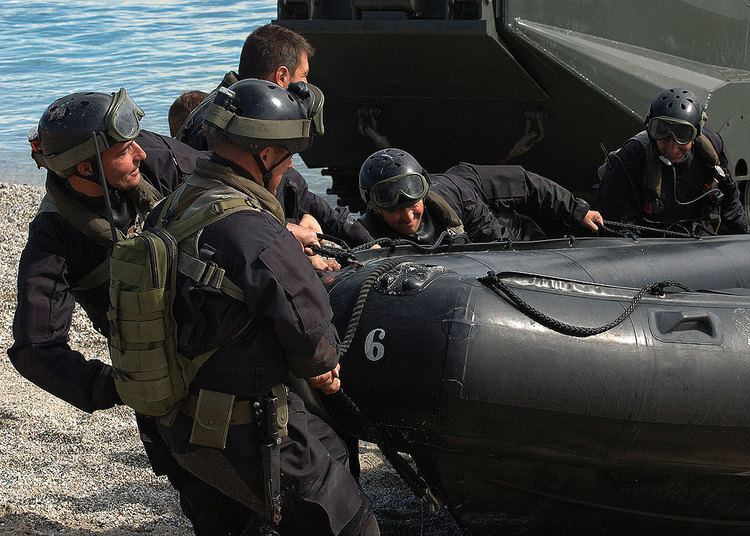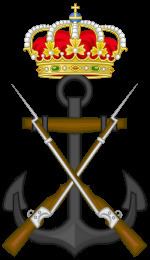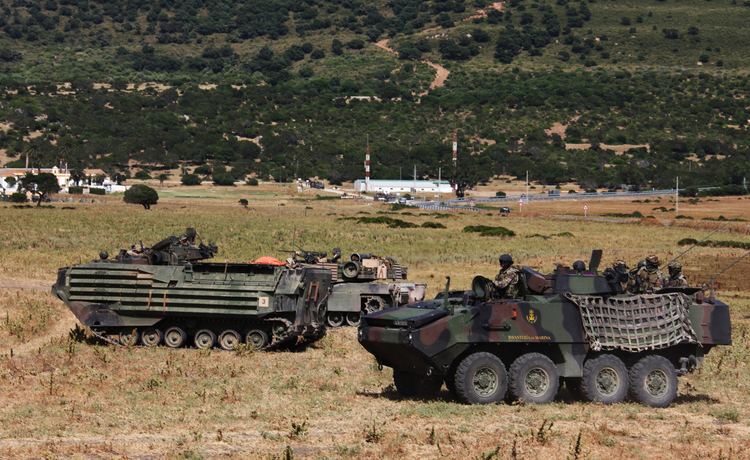Country Spain Type Marines Size 4,680 Marines | Branch Spanish Navy Role Amphibious Warfare Headquarters San Fernando, Spain | |
 | ||
Active February 27, 1537 – present
(480 years) Engagements Spanish Civil War, Battle of Lepanto Similar Spanish Navy, Tercio, Unidad de Operaciones Especiales, Spanish Army, Spanish Armed Forces | ||
Anthem of the spanish navy marines
The Spanish Navy Marines (Spanish: Infantería de Marina; lit, Naval infantry) is a corps within the Spanish Navy (Armada Española) responsible for conducting amphibious warfare by utilizing naval platforms and resources. The Marine Corps is fully integrated into the Armada's structure.
Contents
- Anthem of the spanish navy marines
- Spanish navy marines practice during phoenix express 2010
- Mission
- First period
- Second period
- Third period
- Fourth period
- Fifth period
- Ranks of the Navy Marines
- Other ranks
- Officer ranks
- Original Spanish
- English
- References

The Corps was formed in 1537 by Charles I of Spain (also known as Charles V, Holy Roman Emperor), making it the oldest marine corps in existence in the world, drawing from the Compañías Viejas del Mar de Nápoles.

Spanish navy marines practice during phoenix express 2010
Mission

The Spanish Navy Marines is an elite corps, highly specialised in amphibious warfare, that is, to project an amphibious force onto a hostile, or potentially hostile, coast. Its ability to embark on a short term notice with (land, air and naval) Navy assets, makes it a unit with a high strategic value. Adding to this a high degree of training, and the capability to deploy swiftly in international waters, results in a potent dissuasive force available at a short notice in distant regions.

One of the main characteristics of a marine is the uniform that he wears. On the sleeves of the Spanish Marines are the three "Sardinetas", which marks it as a member of the Royal House Corps. This was given in recognition for a heroic last stand in the Castillo del Morro of Havana, Cuba against a British expedition in 1762. The only other unit to wear the sardinetas and red trouser stripes is the Spanish Royal Guard. Spanish Marines have modern assets to comply with its mission, having personnel specialised in artillery, sapping, helicopters, special operations, communications, tanks, among others. Some vehicles form the Grupo Mecanizado Anfibio del Tercio de Armada (the Mechanized Amphibious Group of the Navy Tercio).

The Marines of Spain are not only a fleet force, as the Spanish Royal Marine Guard Company are responsible for the defense and security forces of naval bases and facilities, naval schools and training units, and all facilities that support the Marines themselves.
The most famous Spanish Marine is without a doubt Miguel de Cervantes, author of the novel Don Quixote, who was wounded in the Battle of Lepanto in 1571. Another famous writer, Pedro Calderón de la Barca, also served with the marines.
First period
The Infantería de Armada (Navy Infantry) was created by Charles V in 1537, when he permanently assigned the Compañías Viejas del Mar de Nápoles (Naples Sea Old Companies) to the Escuadras de Galeras del Mediterráneo (Mediterranean Galley Squadrons). But it was Philip II who established today's concept of a landing force. This was a pure naval power projection ashore by forces deployed from ships that could maintain their ability to fight despite being based on board. This is the period of the famous Tercios (literally "One Third", due to its organisation: one third of musketeers, one third of spearmen and the final third of pikemen):
Of the Tercios above, the first is considered the core of the Spanish Navy Marines, and it bears in its coat of arms two crossed anchors that became the Corps' coat of arms until 1931.
In 1704, the Tercios became regiments: Regimientos de Bajeles (Vessel's Regiments), Regimiento de la Armada (Navy Regiment), R. del Mar de Nápoles (Naples' Sea Regiment), and R. de Marina de Sicilia (Sicily's Navy Regiment), detaching some small units to the Army, and the main body remained in the Navy becoming the Cuerpo de Batallones de Marina (Navy Battalions Corps).
The battles that the marines served in during this very busy period included:
Second period
In 1717 the Cuerpo de Batallones de Marina was definitively settled and organized, reaching its full strength of twelve battalions. The first ones were named: Armada, Bajeles, Marina, Oceano, Mediterráneo and Barlovento. Their mission was to form the "Main body of landing columns and ship's soldiers tasks" in a time that boarding was still a critical part of battle at sea. They were also gun crews.
In a 1793, a woman, Ana Maria de Soto, disguised as a man, and answering to the name of Antonio Maria de Soto, enlisted in the 6th company of 11° Battalion of the Navy, being licensed with pension and honors in 1798, when she was discovered to be a woman. She was the first female Marine of the world.
The major actions they took part in during this period were:
Third period
Though Spain's empire was dismembered in the nineteenth century the marines continued to be active abroad.
Its most important actions in this period were:
These actions were carried out by the Batallones Expedicionarios (Expeditionary Battalions), some of them campaigning abroad for up to ten years.
Fourth period
At the end of the World War I, the Battle of Gallipoli made almost all countries abandon the idea of amphibious assault. The world's marine corps fell into a deep crisis, with the Spanish Navy Marines being no exception, though it enjoyed success during the Third Rif War in its innovative Alhucemas amphibious assault in 1925, when it employed coordinated air and naval gunfire to support the assault.
Owing to its high-profile action in the unpopular Rif Wars, the Spanish Navy Marine corps was branded as a leftover of the Spanish colonial era. After the proclamation of the Second Spanish Republic in 1931, the reforms of the armed forces introduced by newly nominated Republican Minister of War Manuel Azaña within the first months of the new government sought to disband the corps.
Before it was officially disbanded, however, the Spanish Civil War intervened and the corps split and served both sides with the garrisons of Ferrol and Cádiz on the Nationalist side and the garrison of Cartagena, as well as a detachment in Madrid, on the Republican side. During the bitterly fought war the Marines performed garrison duties, led landing parties, and provided expert artillery and machine gun crews. The Republican 151 Brigada Mixta fought mostly inland battles far away from the sea. Photographer Robert Capa took pictures of the Spanish Republican Navy Marines in the Battle of the Segre. Republican Infantería de Marina Lieutenant Colonel Ambrosio Ristori de la Cuadra, killed in action during the Siege of Madrid, was posthumously awarded the Laureate Plate of Madrid.
Fifth period
After the civil war, during the dictatorship of Francisco Franco, the strength of the Infantería Marina was increased. In 1957, the Grupo Especial Anfibio (Amphibious Special Group) was created, and the Spanish Navy Marines returned to its primary duty as a Landing Force Mission. In 1958 it established a beachhead in Spanish Sahara and Ifni during the Ifni War. The capabilities and strength of the Spanish Navy Marines were increased: new amphibious vehicles, anti-tank weapons, individual equipment and artillery.
The Tercio de Armada (TeAr) became the main amphibious unit and has experienced several restructures that led to the E-01 Plan, which defines the requirements and structures from the year 2000 for the Spanish Navy Marines. The Spanish Marines have been present in Europe, Central America and Asia in an anonymous role as an "emergency force" ready to evacuate civilians in conflict areas, or as a deterrence force in providing cover for the actions of allied forces. The current base for the Spanish Marines is in San Fernando.
Today the main fighting Force of the Spanish Marine Infantry is the Marine Infantry Brigade, which includes the following units:
Other Infantry units of the Spanish Navy are:
Ranks of the Navy Marines
Even through the ranks of the Navy Marines are similar to Spanish Army ranks they wear also sleeve and cuff insignia to recognize them as part of the naval establishment, aside from shoulder rank insignia.
